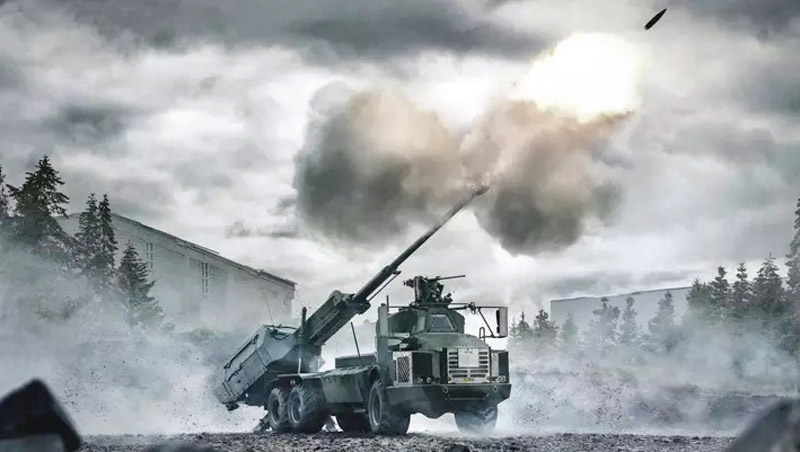Terminally guided munitions will be key differentiator in any future conflict in Himalayas
Atul Chandra
The Indian Army needs to hasten its acquisition of greater numbers of 155 mm Global Positioning System (GPS)-guided artillery shells. The army is now in the unenviable position of not only having to rapidly modernise its holdings of high-calibre artillery systems, but also to stock up on large quantities of precision guided artillery shells. GPS-guided artillery shells, which are also known as Terminally Guided Munitions (TGM), will be a vital battlefield differentiator for any future conflict in the Himalayas, where the ability to undertake precision strikes is key.

The Indian Army is no stranger to precision guided artillery shells, having first inducted the Russian Krasnopol 155 mm laser-guided munition between 1999 and 2002. Media reports have indicated that the army acquired nearly 3,000 Krasnopol rounds. The cost of 1,000 Krasnopol rounds is thought to have been approximately Rs 140 crore, over two decades ago.
Historically, ballistic artillery rounds have been only accurate to approximately 300 meters. In the mountainous terrain of the Himalayas, the undulating terrain and masking effects of hill features require near direct hits to take out the target. The use of GPS-guided precision weapons on the battlefield can ensure near perfect accuracy while reducing the risk of collateral damage. The accuracy of these precision munitions also reduces the number of rounds required to defeat targets. The army is also likely to opt for Precision Guidance Kits (PGK), which can upgrade conventional 155 mm artillery to a level of accuracy that approaches near precision.
The Indian Army’s long delayed Field Artillery Rationalisation Plan (FARP), was supposed to have led to the purchase of approximately 3,000 artillery systems, encompassing 1580 Towed Gun Systems (TGS), 814 Mounted Gun Systems, 180 wheeled Self-Propelled Guns (SPG), 145 Ultra-Light Howitzers (ULH) and 100 tracked Self-Propelled Howitzers (SPH). The latter two have materialised in the BAE Systems M777A2 ULH and Hanwha Aerospace K9 ‘Thunder’ SPH and been inducted into the army. The army’s requirement for an MGS has been in the pipeline since 2002 and in April 2021, a fresh Request for Information (RFI) was issued for procurement of a 155mm/52 cal MGS.
Modern artillery systems are at their deadliest when using GPS-guided munitions, despite their expense. Earlier this year, the Ukraine army’s commander in chief, General Valeriy Zaluzhny, praised the accuracy of US supplied M982 ‘Excalibur’ 155 mm GPS-guided extended range artillery shells. The Excalibur’s capabilities allow for first-round effects-on-target while simultaneously minimising collateral damage and the number of rounds required to engage targets.
A key feature of the Excalibur artillery shell is that regardless of the distance from the gun and the target, the round has the same accuracy with a Circular Error Probability (CEP) of less than 10 meters. Various estimates peg the cost of a single Excalibur artillery shell at approximately USD 1,00,000 (approximately Rs 82 lakh)
In a RFI issued in December 2021 for the procurement of 1,966 rounds of 155 mm TGMs, the ministry of defence (MoD) admitted, rather surprisingly, that there were no TGMs held in the inventory of the artillery. This can certainly be considered as surprising as the 1999 Kargil War has clearly shown the effectiveness and need for guided artillery munitions, for precision strikes with reduced collateral damage.
The RFI calls for the 155 mm TGMs to be developed indigenously as a low-cost option and to obviate dependency on foreign vendors. “The requirement of this ammunition will increase manifold as a majority of the artillery regiments will convert of 155 mm calibre as per the upgradation of the Indian artillery. Thus, sustenance of the industry will be ensured due to continuous demand,” the RFI boldly claimed. But the RFI calls for the delivery of less than 200 TGMs (197 to be exact) a year for 10 years.
This type of 155 mm ammunition is guided to the target by changing its designated course from its ballistic trajectory either by continuous guidance through GPS/GLONASS/IRNSS with INS or by designation of the target via ground-based targeting. The army has asked for these TGMs to have 10 meters CEP at both high and low angles of fire.
As a result, TGMs feature sophisticated technologies, despite outwardly appearing to resemble a simple, unguided artillery shell. The sensitive electronics need to be hardened to withstand the enormous ‘G’ forces generated when such ammunition is fired from a 155 mm howitzer. This type of ammunition features fins and canards that allow the necessary corrections to be made to the ballistic flight path and allows the shells to move on a non-ballistic trajectory to reach the target.
In November 2022, the MoD announced that it had issued a Project Sanction Order to six Developing Agencies (DA) for the development of 155mm TGMs under the Make II scheme. It stated that the army had variants of 155 mm ammunition in its inventory without precision strike capability. These declarations are again surprising as various credible media reports have indicated that the army inducted Excalibur rounds for use on M777 howitzers as early as 2019.
The manufacture of such munitions is an extremely precise task. Can Indian firms develop such technology on their own and profit from the manufacture of only 200 shells annually? Or will it result in essentially licence manufacture of TGMs in India under a Transfer of Technology (ToT) agreement from a foreign OEM?
You must be logged in to view this content.

